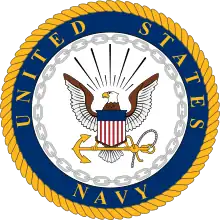Portsmouth Naval Shipyard
The Portsmouth Naval Shipyard, often called the Portsmouth Navy Yard, is a United States Navy shipyard located in Kittery on the southern boundary of Maine near the city of Portsmouth, New Hampshire. PNS is tasked with the overhaul, repair, and modernization of US Navy submarines.[2]
| Portsmouth Naval Shipyard | |
|---|---|
| Seavey's Island, Kittery, Maine | |
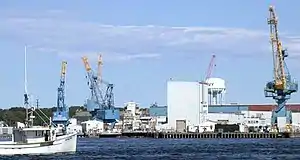 Portsmouth Naval Shipyard in 2004 | |
| Coordinates | 43°4′44″N 70°44′3″W |
| Type | Shipyard |
| Site information | |
| Controlled by | United States Navy |
| Open to the public | No |
| Site history | |
| Built | 1800 |
| In use | 1800–Present |
| Battles/wars | |
Portsmouth Naval Shipyard | |
  | |
| Location | Seavey Island, Kittery, Maine |
| Area | 54 acres (22 ha) |
| Architectural style | Colonial Revival, Greek Revival |
| NRHP reference No. | 77000141[1] |
| Added to NRHP | November 17, 1977 |
| Garrison information | |
| Current commander | Capt. Daniel Ettlich (August 2019-present) |
History
_(1879)_(14596917870).jpg.webp)
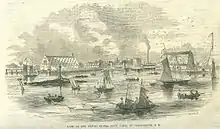
The Portsmouth Naval Shipyard was established on June 12, 1800 during the administration of President John Adams, and is the U.S. Navy's oldest continuously operating shipyard. It sits on a cluster of conjoined islands called Seavey's Island in the Piscataqua River, whose swift tidal current prevents ice from blocking navigation to the Atlantic Ocean.[3]
The area has a long tradition of shipbuilding. Since colonial settlement, New Hampshire and Maine forests provided lumber for wooden boat construction. HMS Falkland was commissioned here in 1696, considered the first British warship built in the Thirteen Colonies. The Royal Navy reserved the tallest and straightest eastern white pine trees for masts, emblazing the bark with a crown symbol. During the Revolution, the Raleigh was built in 1776 on Badger's Island in Kittery, and became the first vessel to fly an American flag into battle. Raleigh has been depicted on the Seal of New Hampshire since 1784, even though she was captured and served in the British Navy. Other warships followed, including Ranger launched in 1777 and commanded by Captain John Paul Jones. It became the first U. S. Navy vessel to receive an official salute at sea from a foreign power. The 36-gun frigate Congress, one of the first six frigates of the United States Navy, was built at the shipyard from 1795 to 1799.
In the 1790s Secretary of the Navy Benjamin Stoddert decided to build the first federal shipyard. He put it where a proven workforce had access to abundant raw materials: Fernald's Island, for which the government paid $5,500. To protect the new installation, old Fort William and Mary at the mouth of Portsmouth Harbor was rebuilt and renamed Fort Constitution.[4]
Commodore Isaac Hull was the first naval officer to command the Portsmouth Naval Shipyard; he led it from 1800 until 1802, and again in 1812 during the War of 1812. The yard's first production was the 74-gun ship of the line Washington, supervised by local master shipbuilder William Badger and launched in 1814. Barracks were built in 1820, with Marine barracks added in 1827. A hospital was established in 1834. Architect Alexander Parris was appointed chief engineer for the base. In 1838, the Franklin Shiphouse was completed -- 240 feet (73 m) long, 131 feet (40 m) wide, and measuring 72 feet (22 m) from floor to center of its ridgepole. It carried 130 tons of slate on a gambrel roof. It was lengthened in 1854 to accommodate Franklin (from which it took its name), the largest wooden warship built at the yard, and requiring a decade to finish. The structure was considered one of the largest shiphouses in the country, but it burned at 5:00 a.m. on 10 March 1936. Perhaps the most famous vessel ever overhauled at the yard was Constitution, also called "Old Ironsides," in 1855.[5]
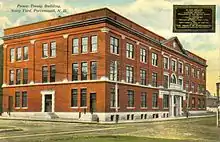
Prisoners of war from the Spanish–American War were encamped in 1898 on the grounds of the base. In 1905, construction began on the Portsmouth Naval Prison, a military prison dubbed "The Castle" because of its resemblance to a crenellated castle. It was the principal prison for the Navy and Marine Corps, as well as housing for many German U-boat crews after capture, until it closed in 1974. Also in 1905, the Portsmouth Navy Yard hosted the Treaty of Portsmouth which ended the Russo-Japanese War.[6] For arranging the peace conference, President Theodore Roosevelt won the 1906 Nobel Peace Prize. Delegates met in the General Stores Building, now the Administration Building (called Building 86). In 2005, a summer-long series of events marked the 100th anniversary of the signing of the treaty, including a visit by a Navy destroyer, a parade, and a re-enactment of the arrival of diplomats from the two nations.
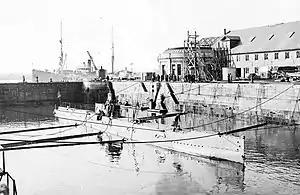
During World War I, the shipyard began constructing submarines, with L-8 being the first ever built by a U. S. navy yard. Meanwhile, the base continued to overhaul and repair surface vessels. Consequently, the workforce grew to nearly 5,000 civilians. It grew to almost 25,000 civilians in World War II when over 70 submarines were constructed at the yard, with a record of 4 launched in a single day. When the war ended, the shipyard became the Navy's center for submarine design and development. In 1953, Albacore revolutionized submarine design around the world with its teardrop hull and round cross-section. It is now a museum and tourist attraction in Portsmouth. Swordfish, the first nuclear-powered submarine built at the base, was launched in 1957. The last submarine built here was Sand Lance, launched in 1969. Today the shipyard provides overhaul, refueling, and modernization work.[5]
In the early years of submarine construction, the wood from lignum vitae tree logs was used for propeller shaft bearings. A small pond at Portsmouth, near the Naval Prison, was used to keep the lignum vitae logs submerged in water in order to prevent the wood from cracking. Although the use of wood was discontinued as construction techniques improved, many of the logs were still present during the construction of USS Jack between 1963 and 1967.
In 1994, the shipyard was placed on the EPA's National Priorities List (NPL) for environmental investigations/restorations under CERCLA (Superfund). The 2005 Base Realignment and Closure Commission placed the yard on a list for base closures, effective by 2008. Employees organized the Save Our Shipyard campaign to influence the committee to reverse its decision. On 24 August 2005, the base was taken off the list and continues operating under its motto, "From Sails to Atoms."[3]
The shipyard earned the Meritorious Unit Commendation in 2005. The MUC recognized the shipyard for meritorious service from September 11, 2001 to August 30, 2004. Portsmouth Naval Shipyard accomplishments achieved during that period included completion of six major submarine availabilities early, exceeding Net Operation Results financial goals, reducing injuries by more than 50 percent, and exceeding the Secretary of Defense's Fiscal Year 2006 Stretch Goal for lost workday compensation rates two years early.
In addition to the Navy presence, the United States Army New England Recruiting Battalion relocated to PNSY in June 2010 from the closed Brunswick Naval Air Station. The United States Coast Guard uses the Portsmouth Navy Yard as the home port for the medium-endurance cutters Reliance, Tahoma, and Campbell.[7]
Boundary dispute
New Hampshire laid claim to the Portsmouth Naval Shipyard until the U.S. Supreme Court dismissed the case in 2001, asserting judicial estoppel.[8] Had it been found to belong to New Hampshire, base employees (and their spouses regardless of whether they themselves worked in Maine) from that state would no longer be required to pay Maine income tax. Despite the court's ruling, New Hampshire's 2006 Session House Joint Resolution 1 reaffirmed its sovereignty assertion over Seavey's Island[9] and the base.
Occupational safety
A CDC / NIOSH study released in 2005 examined the cases of 115 employees at the shipyard who had died of leukemia between 1952 and 1992. The results suggested that leukemia mortality risk increased with increasing cumulative occupational ionizing radiation dose among PNS workers.[10]
Notable ships built at shipyard predecessors
- 1690 — HMS Falkland - (50-gun fourth-rate)[11]
- 1696 — HMS Bedford Galley - (32-gun fifth-rate)[11]
- 1749 — HMS America - (60-gun fourth-rate)[11]
- 1776 — Raleigh - (32-gun frigate)[11]
- 1777 — Ranger - (18-gun sloop-of-war)[11]
- 1782 — America - (74-gun ship of the line)[11]
- 1791 — Scammel - (14-gun schooner)[11]
- 1797 — Crescent - (36-gun frigate)[11]
- 1798 — Portsmouth - (24-gun sloop-of-war)[11]
- 1799 — Congress - (38-gun frigate)[11]
Notable ships built at the Portsmouth Naval Shipyard
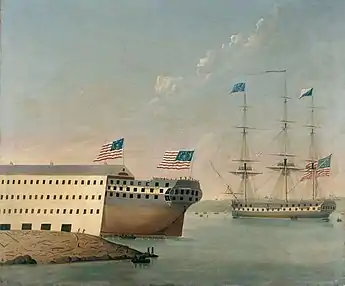
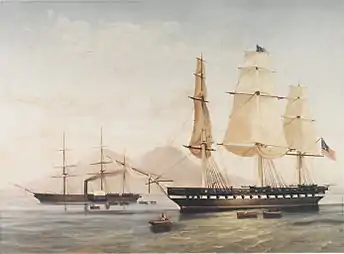
- 1814 — Washington - (74-gun ship of the line)[11]
- 1820 — Porpoise - (11-gun schooner)[11]
- 1828 — Concord - (24-gun sloop-of-war)[11]
- 1839 — Preble - (20-gun sloop-of-war)[11]
- 1841 — Congress - (50-gun frigate)[11]
- 1842 — Saratoga - (24-gun sloop-of-war)[11]
- 1843 — Portsmouth - (24-gun sloop-of-war)[11]
- 1848 — Saranac - (steam sloop)[11]
- 1855 — Santee - (44-gun frigate)[11]
- 1855 — LV-1 - Lightship Nantucket[11]
- 1859 — Mohican - (steam sloop)[11]
- 1861 — Kearsarge - (steam sloop)[11]
- 1861 — Ossipee - (steam sloop)[11]
- 1861 — Sebago - (side-wheel steam gunboat)[11]
- 1861 — Mahaska - (side-wheel steam gunboat)[11]
- 1862 — Sonoma - (side-wheel steam gunboat)[11]
- 1862 — Conemaugh - (side-wheel steam gunboat)[11]
- 1862 — Sassacus - (side-wheel steam gunboat)[11]
- 1862 — Sacramento - (steam sloop)[11]
- 1863 — Nipsic - (steam gunboat)[11]
- 1863 — Shawmut - (steam gunboat)[11]
- 1863 — Agamenticus - (Miantonomoh-class monitor)[11]
- 1864 — New Hampshire - (74-gun ship of the line)[11]
- 1864 — Contoocook - (steam sloop)[11]
- 1864 — Franklin - (steam frigate)[11]
- 1864 — Pawtuxet - (side-wheel steam gunboat)[13]
- 1864 — Blue Light - (tugboat)[11]
- 1864 — Port Fire - (tugboat)[11]
- 1865 — Resaca - (steam gunboat)[11]
- 1866 — Piscataqua - (steam frigate)[11]
- 1867 — Minnetonka - (steam frigate)[11]
- 1868 — Benicia - (steam sloop)[11]
- 1874 — Enterprise - (steam sloop)[11]
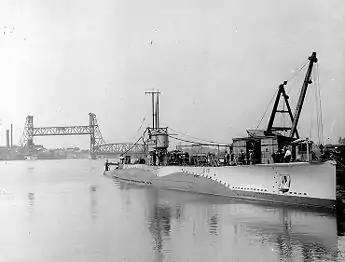
- 1905 — Boxer - (training brigantine)[11]
- 1908 — Patapsco - (tugboat)[11]
- 1917 — L-8 - (United States L-class submarine)[11]
- 1918 — O-1 - (United States O-class submarine)[11]
- 1918 — S-3 - (United States S-class submarine)[11]
- 1919 — S-4 - (United States S-class submarine)[11]
- 1919 — S-5 - (United States S-class submarine)[11]
- 1919 — S-6 - (United States S-class submarine)[11]
- 1920 — S-7 - (United States S-class submarine)[11]
- 1920 — S-8 - (United States S-class submarine)[11]
- 1920 — S-9 - (United States S-class submarine)[11]
- 1920 — S-10 - (United States S-class submarine)[11]
- 1921 — S-11 - (United States S-class submarine)[11]
- 1921 — S-12 - (United States S-class submarine)[11]
- 1921 — S-13 - (United States S-class submarine)[11]
- 1924 — Barracuda - (diesel submarine)[11]
- 1924 — Bass - (diesel submarine)[11]
- 1924 — Bonita - (diesel submarine)[11]
- 1928 — Argonaut - (diesel submarine minelayer)[11] 3 World War II Pacific patrols[14]
- 1929 — Narwhal - (diesel submarine cruiser)[11] sank 6 ships in 15 World War II Pacific patrols[14]
- 1932 — Dolphin - (diesel submarine)[11] 3 World War II Pacific patrols[14]
- 1933 — Cachalot - (diesel submarine)[11] 3 World War II Pacific patrols[14]
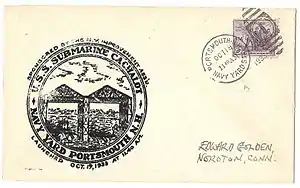 Souvenir of the launch of the USS Cacholot
Souvenir of the launch of the USS Cacholot - 1934 — Hudson - (USCG Calumet-class harbor tug)[15]
- 1935 — Porpoise - (fleet submarine)[11] sank 2 ships in 6 World War II Pacific patrols[14]
- 1935 — Pike - (fleet submarine)[11] sank 1 ship in 8 World War II Pacific patrols[14]
- 1936 — Plunger - (fleet submarine)[11] sank 13 ships in 12 World War II Pacific patrols[14]
- 1936 — Pollack - (fleet submarine)[11] sank 11 ships in 11 World War II Pacific patrols[14]
- 1937 — Snapper - (fleet submarine)[11] sank 4 ships in 11 World War II Pacific patrols[14]
- 1937 — Stingray - (fleet submarine)[11] sank 2 ships in 16 World War II Pacific patrols[14]
- 1938 — Sculpin - (fleet submarine)[11] sank 3 ships in 9 World War II Pacific patrols[14]
- 1939 — Sailfish - (fleet submarine)[11] sank 7 ships in 12 World War II Pacific patrols[14]
- 1939 — Searaven - (fleet submarine)[11] sank 3 ships in 13 World War II Pacific patrols[14]
- 1939 — Seawolf - (fleet submarine)[11] sank 18 ships in 15 World War II Pacific patrols[14]
- 1940 — Triton - (fleet submarine)[11] sank 11 ships in 6 World War II Pacific patrols[14]
- 1940 — Trout - (fleet submarine)[11] sank 12 ships in 11 World War II Pacific patrols[14]
- 1941 — Marlin - (coastal submarine)[11]
- 1940 — Grayling - (fleet submarine)[11] sank 2 ships in 8 World War II Pacific patrols[14]
- 1940 — Grenadier - (fleet submarine)[11] sank 1 ship in 6 World War II Pacific patrols[14]
- 1941 — Drum - (fleet submarine)[11] sank 12 ships in 13 World War II Pacific patrols[14]
- 1941 — Flying Fish - (fleet submarine)[11] sank 15 ships in 12 World War II Pacific patrols[14]
- 1941 — Finback - (fleet submarine)[11] sank 11 ships in 12 World War II Pacific patrols[14]
- 1941 — Haddock - (fleet submarine)[11] sank 8 ships in 13 World War II Pacific patrols[14]
- 1941 — Halibut - (fleet submarine)[11] sank 12 ships in 10 World War II Pacific patrols[14]
- 1942 — Herring - (fleet submarine)[11] sank 6 ships in 5 Atlantic and 3 Pacific World War II patrols[14]
- 1942 — Kingfish - (fleet submarine)[11] sank 14 ships in 12 World War II Pacific patrols[14]
- 1942 — Shad - (fleet submarine)[11] sank 3 ships in 11 World War II Pacific patrols[14]
- 1942 — Runner - (fleet submarine)[11] 3 World War II Pacific patrols[14]
- 1942 — Sawfish - (fleet submarine)[11] sank 6 ships in 10 World War II Pacific patrols[14]
- 1942 — Scamp - (fleet submarine)[11] sank 5 ships in 8 World War II Pacific patrols[14]
- 1942 — Scorpion - (fleet submarine)[11] sank 4 ships in 4 World War II Pacific patrols[14]
- 1942 — Snook - (fleet submarine)[11] sank 17 ships in 9 World War II Pacific patrols[14]
- 1942 — Steelhead - (fleet submarine)[11] sank 4 ships in 7 World War II Pacific patrols[14]

- 1942 — Balao - (fleet submarine)[11] sank 6 ships in 10 World War II Pacific patrols[14]
- 1942 — Billfish - (fleet submarine)[11] sank 3 ships in 8 World War II Pacific patrols[14]
- 1942 — Bowfin - (fleet submarine)[11] sank 16 ships in 9 World War II Pacific patrols[14]
- 1942 — Cabrilla - (fleet submarine)[11] sank 7 ships in 8 World War II Pacific patrols[14]
- 1942 — Capelin - (fleet submarine)[11] sank 1 ship in 1 World War II Pacific patrol[14]
- 1942 — Cisco - (fleet submarine)[11] 1 World War II Pacific patrol[14]
- 1943 — Crevalle - (fleet submarine)[11] sank 8 ships in 7 World War II Pacific patrols[14]
- 1943 — Apogon - (fleet submarine)[11] sank 3 ships in 8 World War II Pacific patrols[14]
- 1943 — Aspro - (fleet submarine)[11] sank 6 ships in 7 World War II Pacific patrols[14]
- 1943 — Batfish - (fleet submarine)[11] sank 6 ships in 7 World War II Pacific patrols[14]
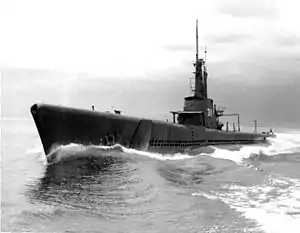
- 1943 — Archerfish - (fleet submarine)[11] sank 2 ships in 7 World War II Pacific patrols[14]
- 1943 — Burrfish - (fleet submarine)[11] sank 1 ship in 6 World War II Pacific patrols[14]
- 1943 — Sand Lance - (fleet submarine)[11] sank 10 ships in 5 World War II Pacific patrols[14]
- 1943 — Picuda - (fleet submarine)[11] sank 13 ships in 6 World War II Pacific patrols[14]
- 1943 — Pampanito - (fleet submarine)[11] sank 5 ships in 6 World War II Pacific patrols[14]
- 1943 — Parche - (fleet submarine)[11] sank 8 ships in 6 World War II Pacific patrols[14]
- 1943 — Bang - (fleet submarine)[11] sank 8 ships in 6 World War II Pacific patrols[14]
- 1943 — Pilotfish - (fleet submarine)[11] 6 World War II Pacific patrols[14]
- 1943 — Pintado - (fleet submarine)[11] sank 8 ships in 6 World War II Pacific patrols[14]
- 1943 — Pipefish - (fleet submarine)[11] sank 2 ships in 6 World War II Pacific patrols[14]
- 1943 — Piranha - (fleet submarine)[11] sank 2 ships in 5 World War II Pacific patrols[14]
- 1943 — Plaice - (fleet submarine)[11] sank 4 ships in 6 World War II Pacific patrols[14]
- 1943 — Pomfret - (fleet submarine)[11] sank 4 ships in 6 World War II Pacific patrols[14]
- 1943 — Sterlet - (fleet submarine)[11] sank 4 ships in 5 World War II Pacific patrols[14]
- 1943 — Queenfish - (fleet submarine)[11] sank 8 ships in 5 World War II Pacific patrols[14]
- 1944 — Razorback - (fleet submarine)[11] 5 World War II Pacific patrols[14]
- 1944 — Redfish - (fleet submarine)[11] sank 5 ships in 2 World War II Pacific patrols[14]
- 1944 — Ronquil - (fleet submarine)[11] sank 2 ships in 5 World War II Pacific patrols[14]
- 1944 — Scabbardfish - (fleet submarine)[11] 5 World War II Pacific patrols[14]
- 1944 — Segundo - (fleet submarine)[11] sank 2 ships in 5 World War II Pacific patrols[14]
- 1944 — Sea Cat - (fleet submarine)[11] 2 World War II Pacific patrols[14]
- 1944 — Sea Devil - (fleet submarine)[11] sank 5 ships in 5 World War II Pacific patrols[14]
- 1944 — Sea Dog - (fleet submarine)[11] sank 9 ships in 4 World War II Pacific patrols[14]
- 1944 — Sea Fox - (fleet submarine)[16] 4 World War II Pacific patrols[14]
- 1944 — Atule - (fleet submarine)[16] sank 6 ships in 4 World War II Pacific patrols[14]
- 1944 — Spikefish - (fleet submarine)[16] sank 1 ship in 4 World War II Pacific patrols[14]
- 1944 — Sea Owl - (fleet submarine)[16] sank 2 ships in 3 World War II Pacific patrols[14]
- 1944 — Sea Poacher - (fleet submarine)[16] 4 World War II Pacific patrols[14]
- 1944 — Sea Robin - (fleet submarine)[16] sank 6 ships in 3 World War II Pacific patrols[14]
- 1944 — Sennet - (fleet submarine)[16] sank 7 ships in 4 World War II Pacific patrols[14]
- 1944 — Piper - (fleet submarine)[16] 3 World War II Pacific patrols[14]
- 1944 — Threadfin - (fleet submarine)[16] sank 3 ships in 3 World War II Pacific patrols[14]
- 1944 — Tench - (fleet submarine)[16] sank 4 ships in 3 World War II Pacific patrols[14]
- 1944 — Thornback - (fleet submarine)[16] 1 World War II Pacific patrol[14]
- 1944 — Tigrone - (fleet submarine)[16] 2 World War II Pacific patrols[14]
- 1944 — Tirante - (fleet submarine)[16] sank 8 ships in 2 World War II Pacific patrols[14]
- 1944 — Trutta - (fleet submarine)[16] 2 World War II Pacific patrols[14]
- 1944 — Toro - (fleet submarine)[16] 2 World War II Pacific patrols[14]
- 1944 — Torsk - (fleet submarine)[16] sank 3 ships in 2 World War II Pacific patrols[14]
- 1944 — Quillback - (fleet submarine)[16] 1 World War II Pacific patrol[14]
- 1944 — Argonaut - (fleet submarine)[16] sank 1 ship in 1 World War II Pacific patrol[14]
- 1944 — Runner - (fleet submarine)[16] sank 1 ship in 2 World War II Pacific patrols[14]
- 1944 — Conger - (fleet submarine)[16]
- 1944 — Cutlass - (fleet submarine)[16] 1 World War II Pacific patrol[14]
- 1944 — Diablo - (fleet submarine)[16] 1 World War II Pacific patrol[14]
- 1944 — Medregal - (fleet submarine)[16]
- 1945 — Requin - (fleet submarine)[16]
- 1945 — Irex - (fleet submarine)[16]
- 1945 — Sea Leopard - (fleet submarine)[16]
- 1945 — Odax - (fleet submarine)[16]
- 1945 — Sirago - (fleet submarine)[16]
- 1945 — Pomodon - (fleet submarine)[16]
- 1945 — Remora - (fleet submarine)[16]
- 1945 — Sarda - (fleet submarine)[16]
- 1945 — Spinax - (fleet submarine)[16]
- 1945 — Volador - (fleet submarine)[16]
- 1951 — Tang - (diesel submarine)[16]
- 1951 — Wahoo - (diesel submarine)[16]
_underway_off_Newport%252C_Rhode_Island_(USA)%252C_on_11_March_1957_(80-G-K-22262).jpg.webp)
- 1951 — Gudgeon - (diesel submarine)[16]
- 1953 — Albacore - (experimental diesel submarine)[16]
- 1955 — Sailfish - (RADAR picket submarine)[16]
- 1956 — Salmon - (RADAR picket submarine)[16]
- 1958 — Growler - (guided missile diesel submarine)[16]
- 1958 — Swordfish - (nuclear submarine)[16]
- 1958 — Barbel - (fast diesel submarine)[16]
- 1958 — Seadragon - (nuclear submarine)[16]
- 1960 — Thresher - (nuclear fast attack submarine)[16]
- 1960 — Abraham Lincoln - (nuclear ballistic missile submarine)[16]
- 1963 — Jack - (nuclear fast attack submarine)[16]
- 1961 — Tinosa - (nuclear fast attack submarine)[16]
- 1963 — John Adams - (nuclear ballistic missile submarine)[16]
- 1964 — Nathanael Greene - (nuclear ballistic missile submarine)[16]
- 1967 — Grayling - (nuclear fast attack submarine)[17]
- 1968 — Dolphin - (experimental diesel submarine)[18]
- 1969 — Sand Lance - (nuclear fast attack submarine)[17]
References
- "National Register Information System". National Register of Historic Places. National Park Service. July 9, 2010.
- Home - Portsmouth Naval Shipyard. Navsea.navy.mil (1939-05-23). Retrieved on 2014-05-24.
- History of the Portsmouth Naval Shipyard
- A. J. Coolidge & J. B. Mansfield, A History and Description of New England; Boston, Massachusetts 1859
- Brief History of the Portsmouth Naval Shipyard
- Treaty of Portsmouth -- U.S. Department of State
- "USCGC RELIANCE". U.S. Coast Guard. Retrieved December 17, 2019.
- Yard in Maine, Portsmouth Herald, 30 May 2001. "Archived copy". Archived from the original on 2005-03-27. Retrieved 2006-11-15.CS1 maint: archived copy as title (link)
- hjr 0001
- "A Nested Case-Control Study of Leukemia and Ionizing Radiation at the Portsmouth Naval Shipyard (2005-104)". CDC - NIOSH Publications and Products -. June 6, 2014. Retrieved 2016-07-15.
- Alden 1964 p. 92
- "Launching of the USS Washington". Historic New England. Retrieved February 20, 2018.
- "Pawtuxet". Dictionary of American Naval Fighting Ships. Naval History and Heritage Command. Retrieved 6 September 2011.
- Blair(1975)pp.875-957
- Fahey 1941 p. 43
- Alden 1964 p. 93
- Blackman 1970-71 p. 466
- Blackman 1970-71 p. 476
- Portsmouth Naval Shipyard Museum & Research Library (Building 31)
- Alden, John, CDR USN (November 1964). "Portsmouth Naval Shipyard". United States Naval Institute Proceedings. Cite journal requires
|journal=(help)CS1 maint: multiple names: authors list (link) - Blackman, Raymond V.B. (1970–71). Jane's Fighting Ships. Jane's Yearbooks.
- Blair, Clay Jr. (1975). Silent Victory volume 2. J.B. Lippincott.
- Fahey, James C. (1941). The Ships and Aircraft of the U.S. Fleet, Two-Ocean Fleet Edition. Ships and Aircraft.
- Switzer, David C. (November 1964). "Down-East Ships of the Union Navy". United States Naval Institute Proceedings. Cite journal requires
|journal=(help) - Watterson, Rodney K. (2011). 32 in '44: Building the Portsmouth Submarine Fleet in World War II. Naval Institute Press. p. 208. ISBN 978-1591149538.
External links
| Wikimedia Commons has media related to Portsmouth Naval Shipyard. |
